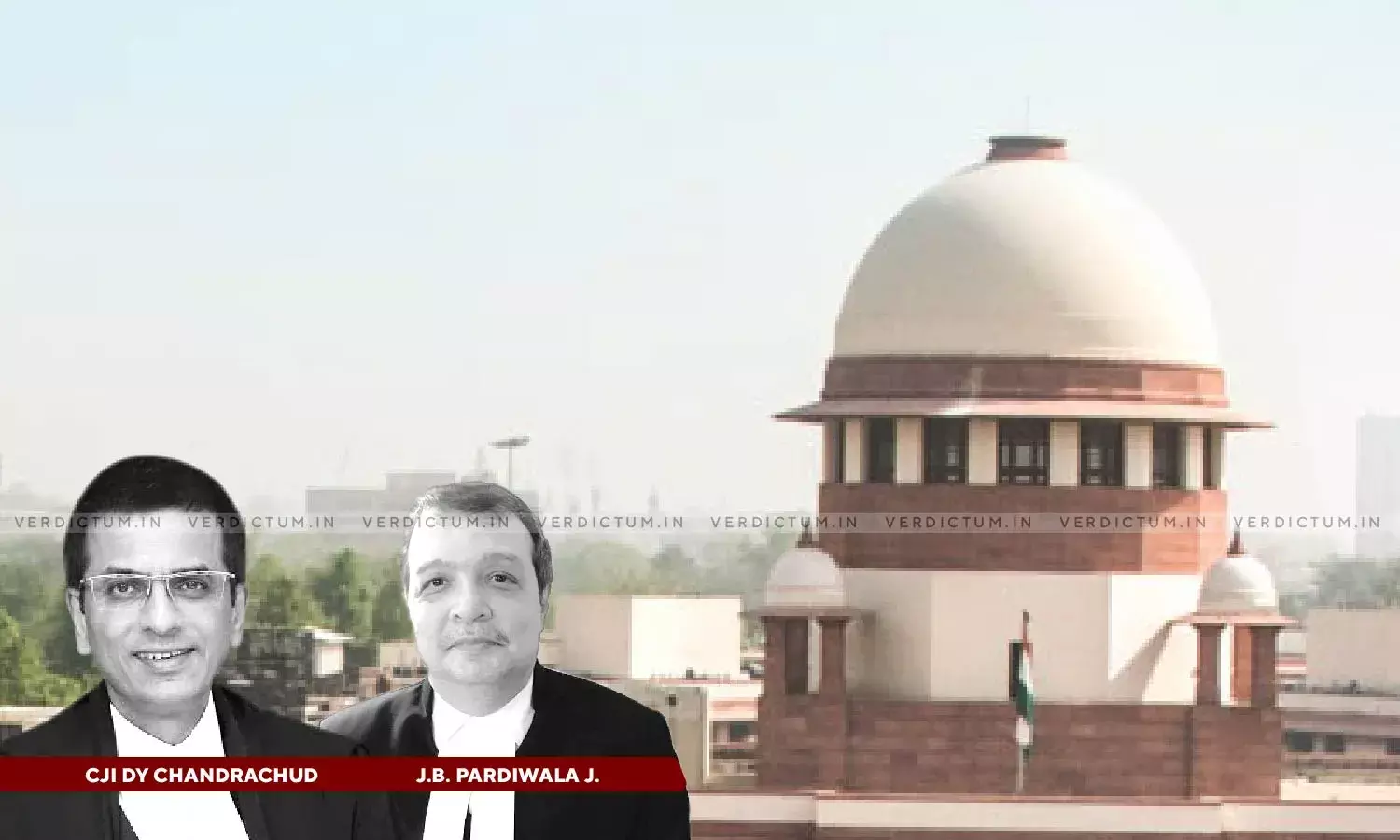Creative Freedom Of Filmmaker Cannot Include Freedom To Lampoon, Stereotype, Misrepresent Or Disparage Those Already Marginalised: SC
The Supreme Court observed that the creative freedom of the filmmaker cannot include the freedom to lampoon, stereotype, misrepresent or disparage those already marginalised.
The Court observed thus in a civil appeal preferred against Sony Pictures Films India Private Limited and laid down comprehensive guidelines for portraying persons with disabilities (PwDs) in visual media.
The two-Judge Bench comprising CJI D.Y. Chandrachud and Justice J.B. Pardiwala held, “In line with the observation in Indibly (supra), we are of the view that the freedom under Article 19(1)(a), that is the creative freedom of the filmmaker cannot include the freedom to lampoon, stereotype, misrepresent or disparage those already marginalised. There is a difference between a film that is set in the backdrop of communal violence and which cannot eschew depiction of violence from portrayal that outright extols such violence.108 Similarly, if the overall message of the work infringes the rights of persons with disabilities, it is not protected speech, obviating the need for any balancing. However, in appropriate cases, if stereotypical/disparaging portrayal is justified by the overall message of the film, the filmmaker’s right to retain such portrayal will have to be balanced against the fundamental and statutory rights of those portrayed.”
The issues that arose for consideration before the Bench included the impact of the provisions of the Rights of Persons with Disabilities Act, 2016 (RPwD Act) on the certification of films under the Cinematograph Act.
Senior Advocate Sanjoy Ghose and Advocate Jai Anant Dehadrai appeared on behalf of the appellants while Senior Advocate Parag Tripathi and Solicitor General of India Tushar Mehta appeared on behalf of the respondents.
Facts of the Case -
The appellant was the founder of an organisation promoting awareness about disabilities, conducting policy research, and providing education to the underprivileged children. He was a person with arthrogryposis and was aggrieved by the manner in which PwDs were portrayed in the movie titled ‘Aankh Micholi’. The appeal arose from the judgment dated January 15, 2024 of the Delhi High Court whereby a petition under Article 226 of the Constitution was dismissed on grounds of maintainability. The appellant addressed a legal notice to Sony Pictures (respondent) in October 2023 raising objections to the trailer of their film. He was particularly aggrieved by the introduction of some of the film characters who were portrayed to suffer from physical impairments.
The movie was released in November 2023 with ‘U’ certification from the Central Board of Film Certification (CBFC). The appellant claimed that the film violated the constitutionality protected rights of PwDs and the provisions of Cinematograph Act and RPwD Act. He claimed that CBFC violated its statutory duty to certify films in accordance with the applicable guidelines. He highlighted instances in the trailer as well as the film where certain medical conditions were misrepresented and derogatory terms were used for characters who are persons with disabilities. He urged that the film’s portrayal is derogatory to persons with disabilities generally and conveys the message that they ought to conceal their impairments in order to deserve a matrimonial partner.
The Apex Court in the above context of the case noted, “The appellant had invoked the writ jurisdiction of the High Court on the ground that the exercise of the second respondent’s fundamental right to freedom of speech and expression, contravened the appellant’s rights under Articles 14, 15 and 21 by reinforcement of stereotypes by the film. … Both these rights are fundamental rights under Article 19(1)(a) and Article 21 respectively. The High Court noted at paragraph 8 of the judgment that since the appellant had not contested the second respondent’s claim that the overall message of the film was about resilience of persons with disability, the primary challenge that the film offended the sensibilities was not established. The countervailing right of freedom of speech and expression of the filmmaker as stated in the previous sections was not weighed against the rights claimed by the appellant.”
The Court added that the High Court could have found that the two rights – the freedom of speech and expression of the filmmaker on the one hand and the rights of persons with disabilities need not be balanced because the rights in question (dignity, non-discrimination and equality) do not include the right to curb the filmmakers’ rights to exhibit a film duly certified for such. It further said that in the alternative, the High Court could have undertaken a balancing of the two rights according to the single or the double proportionality test- depending on whether it felt one of the rights took precedence over the other.
“The High Court rightly does not engage in this discussion perhaps because the appellant expressed satisfaction with a direction for inclusion of expert members to the Board and the Advisory Panel and because the certification of the film was not in issue. Therefore, limiting its inquiry to whether such relief could be granted, the High Court decided against the appellant”, it also noted.
The appellant sought guidelines against filmmakers, regarding the provisions of the RPwD Act and the composition of the Board and the Advisory panel under the Cinematograph Act and recommendations to beep certain parts of the present film as well. Regarding specific recommendations, the Court summarised its views in the following manner –
• It is for the Board to draw the line between permissible and impermissible portrayal of social ills through visual media, and ensure that the Guidelines are meant to be read as broad standards for the same.
• The recommendation that Sony Pictures make an awareness film according to Section 7 (d) of the RPwD Act cannot be granted.
• Under the 1983 Rules, the Board may take steps to assess public reactions to films. The Examining Committee is supposed to include women as its members.
• Courts have also placed adequate thrust on the fitness of these expert committees to assess legal requirements beyond the Cinematograph Act, even with their existing composition.
• The Board must decide whether a disparaging portrayal stood redeemed by the overall message or not.
• Courts cannot trench into policy-making. The High Court was therefore, justified in not granting the abovementioned reliefs and we cannot make recommendations to that effect.
“As long as the overall message of the film justifies the depiction of disparaging language being used against persons with disabilities, it cannot be subjected to restrictions beyond those placed in Article 19(2). However, language that disparages persons with disabilities, marginalises them further and supplements the disabling barriers in their social participation, without the redeeming quality of the overall message of such portrayal must be approached with caution. Such representation is problematic not because it offends subjective feelings but rather, because it impairs the objective societal treatment of the affected groups by society”, it remarked.
The Court emphasised that representation of persons with disabilities must regard the objective social context of their representation and not marginalise persons with disability.
Accordingly, the Supreme Court disposed of the appeal.
Cause Title- Nipun Malhotra v. Sony Pictures Films India Private Limited & Ors. (Neutral Citation: 2024 INSC 465)
Appearance:
Appellant: Senior Advocate Sanjoy Ghose, Advocate Jai Anant Dehadrai, AOR Pulkit Agarwal, Advocates Sudhanshu Kaushesh, Siddharth Sharma, Md Tasnimul Hassan, Martin George, Prashant Kumar, Md Anas Chaudhary, Md Sharyab Ali, Zahid Ali, Vibhu Tandon, and Avnish Chaturvedi.
Respondents: Senior Advocate Parag Tripathi, Solicitor General of India Tushar Mehta, Advocates Ritin Rai, Alipak Banerjee, Karishma Karthik, AOR Salvador Santosh Rebello, Advocates Raghav Sharma, Kritika Grover, Jaskirat Pal Singh, Prateek Tanmay, Madhav Sinhal, Sansriti Pathak, Mayank Pandey, Aarushi Singh, and AOR Amrish Kumar.












